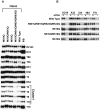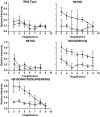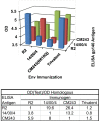Neutralizing antibody responses in macaques induced by human immunodeficiency virus type 1 monovalent or trivalent envelope glycoproteins
- PMID: 23533650
- PMCID: PMC3606129
- DOI: 10.1371/journal.pone.0059803
Neutralizing antibody responses in macaques induced by human immunodeficiency virus type 1 monovalent or trivalent envelope glycoproteins
Abstract
A major goal of efforts to develop a vaccine to prevent HIV-1 infection is induction of broadly cross-reactive neutralizing antibodies (bcnAb). In previous studies we have demonstrated induction of neutralizing antibodies that did cross-react among multiple primary and laboratory strains of HIV-1, but neutralized with limited potency. In the present study we tested the hypothesis that immunization with multiple HIV-1 envelope glycoproteins (Envs) would result in a more potent and cross-reactive neutralizing response. One Env, CM243(N610Q), was selected on the basis of studies of the effects of single and multiple mutations of the four gp41 glycosylation sites. The other two Envs included R2 (subtype B) and 14/00/4 (subtype F), both of which were obtained from donors with bcnAb. Rhesus monkeys were immunized using a prime boost regimen as in previous studies. Individual groups of monkeys were immunized with either one of the three Envs or all three. The single N610Q and N615Q mutations of CM243 Env did not disrupt protein secretion, processing into, or reactivity with mAbs, unlike other single or multiple deglycosylation mutations. In rabbit studies the N610Q mutation alone or in combination was associated with an enhanced neutralizing response against homologous and heterologous subtype E viruses. In the subsequent monkey study the response induced by the R2 Env regimen was equivalent to the trivalent regimen and superior to the other monovalent regimens against the virus panel used for testing. The 14/00/4 Env induced responses superior to CM243(N610Q). The results indicate that elimination of the glycosylation site near the gp41 loop results in enhanced immunogenicity, but that immunization of monkeys with these three distinct Envs was not more immunogenic than with one.
Conflict of interest statement
Figures





Similar articles
-
HIV-1 Cross-Reactive Primary Virus Neutralizing Antibody Response Elicited by Immunization in Nonhuman Primates.J Virol. 2017 Oct 13;91(21):e00910-17. doi: 10.1128/JVI.00910-17. Print 2017 Nov 1. J Virol. 2017. PMID: 28835491 Free PMC article.
-
Antigenicity and immunogenicity of transmitted/founder, consensus, and chronic envelope glycoproteins of human immunodeficiency virus type 1.J Virol. 2013 Apr;87(8):4185-201. doi: 10.1128/JVI.02297-12. Epub 2013 Jan 30. J Virol. 2013. PMID: 23365441 Free PMC article.
-
Comparison of Immunogenicity in Rhesus Macaques of Transmitted-Founder, HIV-1 Group M Consensus, and Trivalent Mosaic Envelope Vaccines Formulated as a DNA Prime, NYVAC, and Envelope Protein Boost.J Virol. 2015 Jun;89(12):6462-80. doi: 10.1128/JVI.00383-15. Epub 2015 Apr 8. J Virol. 2015. PMID: 25855741 Free PMC article.
-
Clade C HIV-1 Envelope Vaccination Regimens Differ in Their Ability To Elicit Antibodies with Moderate Neutralization Breadth against Genetically Diverse Tier 2 HIV-1 Envelope Variants.J Virol. 2019 Mar 21;93(7):e01846-18. doi: 10.1128/JVI.01846-18. Print 2019 Apr 1. J Virol. 2019. PMID: 30651354 Free PMC article.
-
Cross-reactivity of HIV vaccine responses and the microbiome.Curr Opin HIV AIDS. 2018 Jan;13(1):9-14. doi: 10.1097/COH.0000000000000423. Curr Opin HIV AIDS. 2018. PMID: 29035947 Free PMC article. Review.
Cited by
-
Soluble HIV-1 envelope immunogens derived from an elite neutralizer elicit cross-reactive V1V2 antibodies and low potency neutralizing antibodies.PLoS One. 2014 Jan 23;9(1):e86905. doi: 10.1371/journal.pone.0086905. eCollection 2014. PLoS One. 2014. PMID: 24466285 Free PMC article.
-
Characterization and Implementation of a Diverse Simian Immunodeficiency Virus SIVsm Envelope Panel in the Assessment of Neutralizing Antibody Breadth Elicited in Rhesus Macaques by Multimodal Vaccines Expressing the SIVmac239 Envelope.J Virol. 2015 Aug;89(16):8130-51. doi: 10.1128/JVI.01221-14. Epub 2015 May 27. J Virol. 2015. PMID: 26018167 Free PMC article.
-
New prospects for a preventive HIV-1 vaccine.J Virus Erad. 2015 Apr;1(2):78-88. J Virus Erad. 2015. PMID: 26523292 Free PMC article.
References
-
- Beirnaert E, De Zutter S, Janssens W, van der Groen G (2001) Potent broad cross-neutralizing sera inhibit attachment of primary HIV-1 isolates (groups M and O) to peripheral blood mononuclear cells. Virology 281: 305–314. - PubMed
-
- Quinnan GV Jr, Zhang PF, Fu DW, Dong M, Alter HJ (1999) Expression and characterization of HIV type 1 envelope protein associated with a broadly reactive neutralizing antibody response. AIDS Res Hum Retroviruses 15: 561–570. - PubMed
-
- Donners H, Willems B, Beirnaert E, Colebunders R, Davis D, et al. (2002) Cross-neutralizing antibodies against primary isolates in African women infected with HIV-1. Aids 16: 501–503. - PubMed
Publication types
MeSH terms
Substances
Grants and funding
LinkOut - more resources
Full Text Sources
Other Literature Sources

